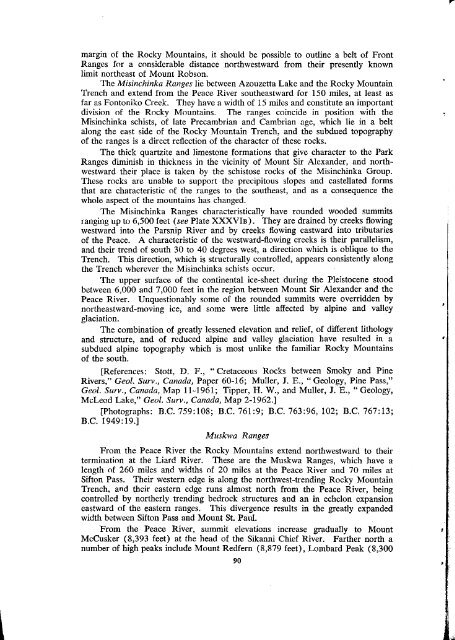Landforms of British Columbia 1976 - Department of Geography
Landforms of British Columbia 1976 - Department of Geography
Landforms of British Columbia 1976 - Department of Geography
You also want an ePaper? Increase the reach of your titles
YUMPU automatically turns print PDFs into web optimized ePapers that Google loves.
margin <strong>of</strong> the Rocky Mountains% it should be possible to outIine a belt <strong>of</strong> Front<br />
Ranges for a considerable distance northwestward from their presently known<br />
limit northeast <strong>of</strong> Mount Robson.<br />
The hfkinchinka i?anges lie between Azouzetta Lake and the Rocky Mountain<br />
Trench and extend from the Peace River southeastward for 150 miles, at least as<br />
far as Fontoniko Creek. They have a width <strong>of</strong> 15 miles and constitute an important<br />
division <strong>of</strong> the Rocky Mountains. The ranges coincide in position with the<br />
Misinchinka schists, <strong>of</strong> late Precambrian and Cambrian age, which lie in a belt<br />
along the east side <strong>of</strong> the Rocky Mountain Trench, and the subdued topography<br />
<strong>of</strong> the ranges is a direct reflection <strong>of</strong> the character <strong>of</strong> these rocks.<br />
The thick quart&e and limestone formations that give character to the Park<br />
Ranges diminish in thickness in the vicinity <strong>of</strong> Mount Sir Alexander, and north-<br />
westward their place is taken by the schistose rocks <strong>of</strong> the Misinchinka Group.<br />
These rocks are unable to support the precipitous slopes and cast&&d forms<br />
that are chamcteristic <strong>of</strong> the ranges to the southeast, and as a consequence the<br />
whole aspect <strong>of</strong> the mountains has changed.<br />
The Misinchinka Ranges characteristically have rounded wooded summits<br />
ranging up to 6,500 feet (see Plate XXXVIB). They are drained by creeks flowing<br />
westward into the Parsnip River and by creeks flowing eastward into tributaries<br />
<strong>of</strong> the Peace. A characteristic <strong>of</strong> the westward-flowing creeks is their parallelism,<br />
and theix trend <strong>of</strong> south 30 to 40 degrees west, a direction which is oblique to the<br />
Trench. This direction, which is structurally controlled, appears consistently along<br />
the Trench wherever the Misinchinka schists occur.<br />
The upper surface <strong>of</strong> the continental ice-sheet during the Pleistocene stood<br />
between 6,000 and 7,000 feet in the region between Mount Sir Alexander and the<br />
Peace River. Unquestionably some <strong>of</strong> the rounded summits were overridden by<br />
northeastward-moving ice, and some were little affected by alpine and valley<br />
glaciation.<br />
The combination <strong>of</strong> greatly lessened elevation and relief, <strong>of</strong> different lithology<br />
and structure, and <strong>of</strong> reduced aIpine and valley glaciation have resulted in a<br />
subdued alpine topography which is most unlike the familiar Rocky Mountains<br />
<strong>of</strong> the south.<br />
[References: Stott, D. F., “ Cretaceous Rocks between Smoky and Pine<br />
Rivers,” Geol. Surv., Cmadu, Paper 60-16; Muller, J. E., “ Geology, Pine Pass,”<br />
Geol. Surv., Canada, Map 11-1961; Tipper, H. W., and Muller, .I. E., “Geology,<br />
McLeod Lake,” Geol. Surv., Canada, Map Z-1962.]<br />
[Photographs: B.C. 759:108; B.C. 761:9; B.C. 763:96, 102; B.C. 767:13;<br />
B.C. 1949:19.]<br />
Muskwa Ranges<br />
From the Peace River the Rocky Mountains extend northwestward to their<br />
termination at the Liard River. These are the Muskwa Ranges, which have a<br />
length <strong>of</strong> 260 miles and widths <strong>of</strong> 20 miles at the Peace River and 70 miles at<br />
Sifton Pass. Their western edge is along the northwest-trending Rocky Mountain<br />
Trench, and their eastern edge runs almost north from the Peace River, being<br />
controlled by northerly trending bedrock structures and an in echelon expansion<br />
eastward <strong>of</strong> the eastern ranges. This divergence results in the greatly expanded<br />
width between Sifton Pass and Mount St. Paul.<br />
From the Peace River, summit elexitions increase gradually to Mount<br />
McCusker (8,393 feet) at the head <strong>of</strong> the Sikanni Chief River. Farther north a<br />
number <strong>of</strong> high peaks include Mount Redfern (8,879 feet), Lombard Peak (8,300<br />
90











